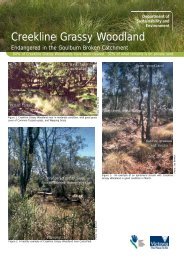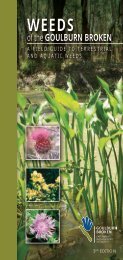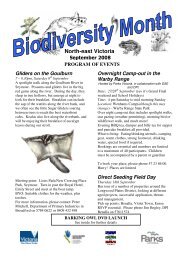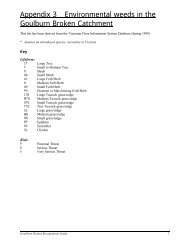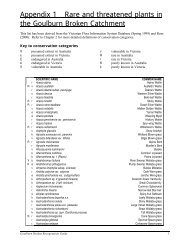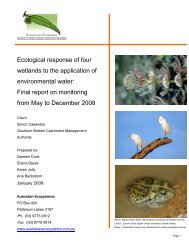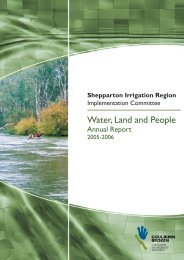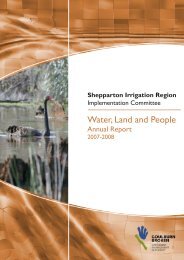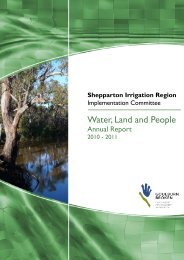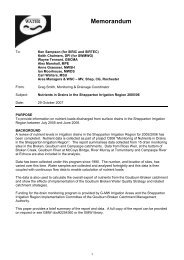Water, Land and People - Goulburn Broken Catchment ...
Water, Land and People - Goulburn Broken Catchment ...
Water, Land and People - Goulburn Broken Catchment ...
Create successful ePaper yourself
Turn your PDF publications into a flip-book with our unique Google optimized e-Paper software.
M<strong>and</strong>atory Environmental Monitoring<br />
M<strong>and</strong>atory Environmental Monitoring was undertaken<br />
once in 2008-2009 at the seven allocated sites, four<br />
terrestrial sites <strong>and</strong> three wetl<strong>and</strong> sites. Ongoing<br />
collation of data is stored for each site, including photopoints,<br />
species presence <strong>and</strong> absence <strong>and</strong> water/macro<br />
invertebrate (where applicable) sampling.<br />
A review of all the environmental monitoring processes<br />
that occur in the Shepparton Irrigation Region was<br />
initiated this year <strong>and</strong> will be completed in 2009-2010.<br />
Modernisation<br />
The Environment Program has been involved in<br />
modernisation projects across the Shepparton Irrigation<br />
Region. Examples of the activities are highlighted below:<br />
• An “Optional Environmental <strong>Water</strong>ing Points for<br />
High Value Wetl<strong>and</strong>s” report is being written for the<br />
Northern Victoria Irrigation Renewal Project. This<br />
will be completed in 2009-2010 <strong>and</strong> will provide<br />
data on alternative water supply points for wetl<strong>and</strong>s<br />
across the Shepparton Irrigation Region when the<br />
Northern Victoria Irrigation Renewal Project is ready<br />
to rationalise that part of the irrigation infrastructure<br />
that may currently provide a supply point to these<br />
wetl<strong>and</strong>s;<br />
• The Reedy Swamp Environmental <strong>Water</strong>ing Plan<br />
is currently being written. This plan will assist with<br />
the delivery of water to wetl<strong>and</strong>s via channels <strong>and</strong><br />
surface water management systems <strong>and</strong> highlight<br />
the issues that may arise from decommissioning or<br />
rationalising irrigation channels in these areas.<br />
<strong>L<strong>and</strong></strong>scape Links<br />
The Environment Program has been assisting the<br />
<strong>Goulburn</strong> Valley Environment Group in developing<br />
the <strong>L<strong>and</strong></strong>scape Links project. This will encourage<br />
planting of native vegetation on channels that are to<br />
be decommissioned as part of the implementation of<br />
the Northern Victoria Irrigation Renewal Project, to<br />
create <strong>and</strong> enhance links of native vegetation across the<br />
l<strong>and</strong>scape. An information kit for use by l<strong>and</strong>holders <strong>and</strong><br />
consultants was developed.<br />
Biodiversity<br />
Written by Tim Barlow, GB CMA; Shelagh Kurmi, Trust<br />
for Nature; Filippa Schapper, Superb Parrot Project<br />
Group <strong>and</strong> Rolf Weber, Department of Sustainability <strong>and</strong><br />
Environment<br />
The Superb Parrot is an endangered bird, endemic<br />
to south-eastern Australia <strong>and</strong> listed under the<br />
Commonwealth’s Environment Protection <strong>and</strong><br />
Biodiversity Conservation (EPBC) Act. In Victoria, it is<br />
restricted to the Barmah region where some 200-400<br />
birds are known to occur (numbers vary in different<br />
years according to mortality <strong>and</strong> breeding success). Whilst<br />
large old River Red Gums provide essential breeding sites<br />
(hollows), the Superb Parrot requires foraging habitat<br />
provided by a shrubby understorey in box woodl<strong>and</strong> <strong>and</strong><br />
secure flight paths to <strong>and</strong> from the nests. The Superb<br />
Parrot Group has been active for many years promoting<br />
awareness of the foraging needs <strong>and</strong> encouraging<br />
l<strong>and</strong>holders to undertake direct seeding <strong>and</strong> revegetation<br />
to supplement available habitat. This has yielded dividends<br />
for the birds as well, with increasing numbers being<br />
sighted outside the breeding season, indicating more<br />
resources are becoming available in the area.<br />
As a result of the continuing drought the committee<br />
decided to focus on direct seeding <strong>and</strong> remnant<br />
protection in 2008-2009 with 41.6ha fenced <strong>and</strong> 20ha<br />
direct seeded; the remainder ripped ready for planting<br />
in 2010. In addition 17 people participated in the annual<br />
population census of Superb Parrots in the Barmah area.<br />
The census located some 180 birds which is slightly down<br />
on 2007-2008 but there were reports of large flocks<br />
feeding on crops beyond the bird count range. The official<br />
count for the year (by all observers) recorded 315 birds,<br />
a slight increase from 2007–2008.<br />
The high attendance of 42 members at the Annual<br />
General meeting warmly received keynote speaker Elisa<br />
Tack’s report on her PhD work on the bush stone curlew.<br />
The Superb Parrot Project Group continues their long<br />
term commitment to work on habitat protection <strong>and</strong><br />
development.<br />
Threatened Species Recovery Plan<br />
implementation <strong>and</strong> monitoring<br />
The Department of Sustainability <strong>and</strong> Environment<br />
undertake a range of activities on behalf of the<br />
Shepparton Irrigation Region Implementation Committee<br />
to implement actions recommended in recovery plans for<br />
terrestrial <strong>and</strong> aquatic flora <strong>and</strong> fauna.<br />
During 2008-2009, this work included monitoring<br />
populations of flora species including Mueller’s Daisy<br />
(Brachyscome muelleroides), Bald-tip Beard-orchid<br />
(Calochilus richiae), Nagambie Swamp Leek-orchid<br />
(Prasophyllum hygrophilum), Red Swainson-pea<br />
(Swainsona plagiotropis), Slender Darling-pea (Swainsona<br />
murrayana), Turnip Copperburr (Sclerolaena napiformis)<br />
ACTIVITIES AND ACHIEVEMENTS<br />
15



